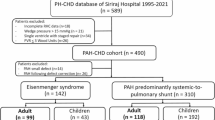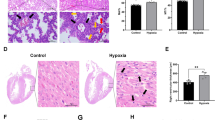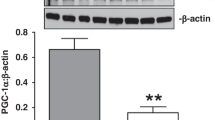Abstract
Hypoxia-induced pulmonary vascular remodeling (HPVR) may lead to persistent pulmonary hypertension of the newborn or cor pulmonale. Endothelin-1 (ET-1), via endothelin-A (ETA) receptor activation, mediates hypoxic pulmonary vasoconstriction. Our objectives were to develop a newborn mouse model of HPVR and to test the hypothesis that ETA blockade would prevent and reverse HPVR in this model. C57BL/6 mice (n = 64) were exposed to 12% oxygen (HYP group) or room air (RA group) from birth to 2 wk of age. The mice were injected intraperitoneally daily with either BQ-610 (ETA blocker) or vehicle (cottonseed oil) from birth (prevention study) or from 6 d of age (reversal study). HPVR was assessed histologically by pulmonary vascular morphometry by an examiner masked to study group, and by measurement of the right ventricle to left ventricle (RV/LV) thickness ratio. Hypoxia increased medial wall thickness (%WT) in pulmonary arteries <100 μm in diameter and RV/LV thickness ratio. BQ-610 prevented the hypoxia-induced increase in %WT and RV/LV thickness ratio when given from birth, and later therapy partially reversed the hypoxia-induced increase in %WT but not RV/LV thickness ratio. These data show that in the newborn mouse model, chronic hypoxia leads to HPVR that can be completely prevented and partially reversed by ETA blockade. These results indicate that ET-1, acting via ETA receptors, is a mechanism of pathophysiologic significance underlying neonatal HPVR. Development of this newborn mouse model of HPVR facilitates investigation of mechanisms underlying this important and severe disease entity in human infants.
Similar content being viewed by others
Log in or create a free account to read this content
Gain free access to this article, as well as selected content from this journal and more on nature.com
or
Abbreviations
- ET-1:
-
endothelin-1
- ETA:
-
endothelin-A receptor
- HPVR:
-
hypoxia-induced pulmonary vascular remodeling
- PPHN:
-
persistent pulmonary hypertension of the newborn
- %WT:
-
percentage wall thickness of tunica media as compared to external diameter
References
Murphy JD, Vawter GF, Reid LM 1984 Pulmonary vascular disease in fatal meconium aspiration. J Pediatr 104: 758–762
Drummond WH, Bissonnette JM 1978 Persistent pulmonary hypertension in the neonate: development of an animal model. Am J Obstet Gynecol 131: 761–763
Stenmark KR, Fasules J, Hyde DM, Voelkel NF, Henson J, Tucker A, Wilson H, Reeves JT 1987 Severe pulmonary hypertension and arterial adventitial changes in newborn calves at 4,300 m. J Appl Physiol 62: 821–830
Fike CD, Kaplowitz MR 1994 Effect of chronic hypoxia on pulmonary vascular pressures in isolated lungs of newborn pigs. J Appl Physiol 77: 2853–2862
Walsh-Sukys MC 1993 Persistent pulmonary hypertension of the newborn. The black box revisited. Clin Perinatol 20: 127–143
Goodman G, Perkin RM, Anas NG, Sperling DR, Hicks DA, Rowen M 1988 Pulmonary hypertension in infants with bronchopulmonary dysplasia. J Pediatr 112: 67–72
Hoffmeister HM, Apitz J, Hoffmeister HE, Fischbach H 1981 The correlation between blood pressure and morphometric findings in children with congenital heart disease and pulmonary hypertension. Basic Res Cardiol 76: 647–656
Steinhorn RH, Fineman JR 1999 The pathophysiology of pulmonary hypertension in congenital heart disease. Artif Organs 23: 970–974
Ziegler JW, Ivy DD, Kinsella JP, Abman SH 1995 The role of nitric oxide, endothelin, and prostaglandins in the transition of the pulmonary circulation. Clin Perinatol 22: 387–403
Ortega Mateo A, de Artinano AA 1997 Highlights on endothelins: a review. Pharmacol Res 36: 339–351
Wong J, Vanderford PA, Fineman JR, Chang R, Soifer SJ 1993 Endothelin-1 produces pulmonary vasodilation in the intact newborn lamb. Am J Physiol 265: H1318–H1325
Bradley LM, Czaga JF, Goldstein RE 1990 Circulatory effects of endothelin in newborn piglets. Am J Physiol 259: H1613–H1617
Barnard JW, Barman SA, Adkins WK, Longenecker GL, Taylor AE 1991 Sustained effects of endothelin-1 on rabbit, dog, and rat pulmonary circulations. Am J Physiol 261: H479–H486
Sekine T, Kusano H, Nishimaru K, Tanaka Y, Tanaka H, Shigenobu K 1999 Developmental conversion of inotropism by endothelin I and angiotensin II from positive to negative in mice. Eur J Pharmacol 374: 411–415
Giannessi D, Del Ry S, Andreassi MG, Nardini V, Pelosi G, Colombo MG, Biagini A 1999 High density of endothelin binding sites in the hearts of infants and children. Life Sci 64: 697–705
Kumar P, Kazzi NJ, Shankaran S 1996 Plasma immunoreactive endothelin-1 concentrations in infants with persistent pulmonary hypertension of the newborn. Am J Perinatol 13: 335–341
Rosenberg AA, Kennaugh J, Koppenhafer SL, Loomis M, Chatfield BA, Abman SH 1993 Elevated immunoreactive endothelin-1 levels in newborn infants with persistent pulmonary hypertension. J Pediatr 123: 109–114
Ambalavanan N, Philips JB III, Bulger A, Oparil S, Chen YF 2002 Endothelin-A receptor blockade in porcine pulmonary hypertension. Pediatr Res 52: 913–921
DiCarlo VS, Chen SJ, Meng QC, Durand J, Yano M, Chen YF, Oparil S 1995 ETA-receptor antagonist prevents and reverses chronic hypoxia-induced pulmonary hypertension in rat. Am J Physiol 269: L690–L697
Chen SJ, Chen YF, Opgenorth TJ, Wessale JL, Meng QC, Durand J, DiCarlo VS, Oparil S 1997 The orally active nonpeptide endothelin A-receptor antagonist A-127722 prevents and reverses hypoxia-induced pulmonary hypertension and pulmonary vascular remodeling in Sprague-Dawley rats. J Cardiovasc Pharmacol 29: 713–725
Rabinovitch M, Gamble WJ, Miettinen OS, Reid L 1981 Age and sex influence on pulmonary hypertension of chronic hypoxia and on recovery. Am J Physiol 240: H62–H72
Kelly DA, Hislop AA, Hall SM, Haworth SG 2002 Correlation of pulmonary arterial smooth muscle structure and reactivity during adaptation to extrauterine life. J Vasc Res 39: 30–40
Ebihara I, Nakamura T, Tomino Y, Koide H 1997 Effect of a specific endothelin receptor A antagonist and an angiotensin-converting enzyme inhibitor on glomerular mRNA levels for extracellular matrix components, metalloproteinases (MMP) and a tissue inhibitor of MMP in aminonucleoside nephrosis. Nephrol Dial Transplant 12: 1001–1006
Chen SJ, Chen YF, Meng QC, Durand J, Dicarlo VS, Oparil S 1995 Endothelin-receptor antagonist bosentan prevents and reverses hypoxic pulmonary hypertension in rats. J Appl Physiol 79: 2122–2131
Rabinovitch M, Gamble W, Nadas AS, Miettinen OS, Reid L 1979 Rat pulmonary circulation after chronic hypoxia: hemodynamic and structural features. Am J Physiol 236: H818–H827
Burri P 1997 Structural aspects of prenatal and postnatal development and growth for the lung. In: McDonald JA (ed) Lung Growth and Development. Dekker, New York, pp 1–35
Amy RW, Bowes D, Burri PH, Haines J, Thurlbeck WM 1977 Postnatal growth of the mouse lung. J Anat 124: 131–151
Vicencio AG, Eickelberg O, Stankewich MC, Kashgarian M, Haddad GG 2002 Regulation of TGF-beta ligand and receptor expression in neonatal rat lungs exposed to chronic hypoxia. J Appl Physiol 93: 1123–1130
Sekhon HS, Thurlbeck WM 1996 Lung morphometric changes after exposure to hypobaria and/or hypoxia and undernutrition. Respir Physiol 106: 99–107
Ivy DD, Parker TA, Zeigler JW, Galan HL, Kinsella JP, Tuder RM, Abman SH 1997 Prolonged endothelin A receptor blockade attenuates chronic pulmonary hypertension in the ovine fetus. J Clin Invest 99: 1179–1186
Perreault T, Berkenbosch JW, Barrington KJ, Decker ER, Wu C, Brock TA, Baribeau J 2001 TBC3711, an ET(A) receptor antagonist, reduces neonatal hypoxia-induced pulmonary hypertension in piglets. Pediatr Res 50: 374–383
Rabinovitch M 1996 Cell-extracellular matrix interactions in the ductus arteriosus and perinatal pulmonary circulation. Semin Perinatol 20: 531–541
Wohrley JD, Frid MG, Moiseeva EP, Orton EC, Belknap JK, Stenmark KR 1995 Hypoxia selectively induces proliferation in a specific subpopulation of smooth muscle cells in the bovine neonatal pulmonary arterial media. J Clin Invest 96: 273–281
Das M, Dempsey EC, Reeves JT, Stenmark KR 2002 Selective expansion of fibroblast subpopulations from pulmonary artery adventitia in response to hypoxia. Am J Physiol Lung Cell Mol Physiol 282: L976–L986
Li H, Chen SJ, Chen YF, Meng QC, Durand J, Oparil S, Elton TS 1994 Enhanced endothelin-1 and endothelin receptor gene expression in chronic hypoxia. J Appl Physiol 77: 1451–1459
Aversa CR, Oparil S, Caro J, Li H, Sun SD, Chen YF, Swerdel MR, Monticello TM, Durham SK, Minchenko A, Lira SA, Webb ML 1997 Hypoxia stimulates human preproendothelin-1 promoter activity in transgenic mice. Am J Physiol 273: L848–L855
Ivy DD, Kinsella JP, Abman SH 1994 Physiologic characterization of endothelin A and B receptor activity in the ovine fetal pulmonary circulation. J Clin Invest 93: 2141–2148
Prendergast B, Newby DE, Wilson LE, Webb DJ, Mankad PS 1999 Early therapeutic experience with the endothelin antagonist BQ-123 in pulmonary hypertension after congenital heart surgery. Heart 82: 505–508
Schulze-Neick I, Li J, Reader JA, Shekerdemian L, Redington AN, Penny DJ 2002 The endothelin antagonist BQ123 reduces pulmonary vascular resistance after surgical intervention for congenital heart disease. J Thorac Cardiovasc Surg 124: 435–441
Rubin LJ, Badesch DB, Barst RJ, Galie N, Black CM, Keogh A, Pulido T, Frost A, Roux S, Leconte I, Landzberg M, Simonneau G 2002 Bosentan therapy for pulmonary arterial hypertension. N Engl J Med 346: 896–903
Givertz MM, Colucci WS, LeJemtel TH, Gottlieb SS, Hare JM, Slawsky MT, Leier CV, Loh E, Nicklas JM, Lewis BE 2000 Acute endothelin A receptor blockade causes selective pulmonary vasodilation in patients with chronic heart failure. Circulation 101: 2922–2927
Author information
Authors and Affiliations
Corresponding author
Additional information
Funded in part by National Heart, Lung, and Blood Institute Grants HL-44195, HL-50147, HL-45990, HL-07457, HL-56046; National Institute of Child Health and Human Development grant K08 HD046513; and a Child Health Research Center Grant through NICHHD P30HD28831.
Presented in part at the meeting of the Pediatric Academic Societies' Annual Meeting, Seattle, WA, 2003.
Rights and permissions
About this article
Cite this article
Ambalavanan, N., Bulger, A., Murphy-Ullrich, J. et al. Endothelin-A Receptor Blockade Prevents and Partially Reverses Neonatal Hypoxic Pulmonary Vascular Remodeling. Pediatr Res 57, 631–636 (2005). https://doi.org/10.1203/01.PDR.0000159512.55862.69
Received:
Accepted:
Issue date:
DOI: https://doi.org/10.1203/01.PDR.0000159512.55862.69
This article is cited by
-
Antagonism of stem cell factor/c-kit signaling attenuates neonatal chronic hypoxia-induced pulmonary vascular remodeling
Pediatric Research (2016)
-
Involvement of the bone morphogenetic protein system in endothelin- and aldosterone-induced cell proliferation of pulmonary arterial smooth muscle cells isolated from human patients with pulmonary arterial hypertension
Hypertension Research (2010)



